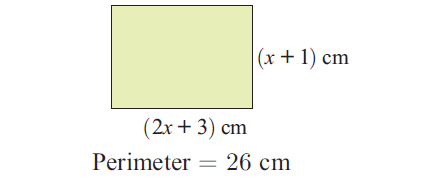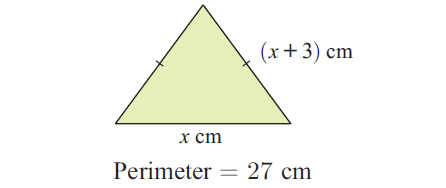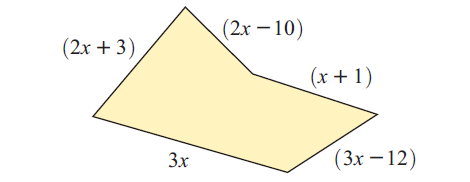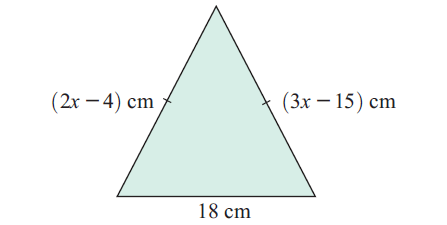POLYNOMIAL WORD PROBLEMS WITH PERIMETER AND AREA
Subscribe to our ▶️ YouTube channel 🔴 for the latest videos, updates, and tips.
Problem 1 :
In the picture shown below, set up an equation and hence find the value of x and find the area.

Solution :
Perimeter = 26
Sum of the lengths of all sides = 26
(2x + 3) + (x + 1) + (2x + 3) + (x + 1) = 26
2x + x + 2x + x + 3 + 1 + 3 + 1 = 26
6x + 8 = 26
6x = 18
x = 3
|
Length : = 2x + 3 = 2(3) + 3 = 6 + 3 = 9 cm |
Width : = x + 1 = 3 + 1 = 4 cm |
Area of rectangle :
= length x width
= 9 x 4
= 36 cm2
Problem 2 :
Find the value of x.

Solution :
Perimeter of the triangle = 27
From the picture it is a isosceles triangle, so two sides will be equal.
x + (x + 3) + (x + 3) = 27
x + x + 3 + x + 3 = 27
3x + 6 = 27
3x = 21
x = 7
Problem 3 :
Find x, given that the square and the rectangle have equal areas.

Solution :
Area of square = Area of rectangle
x2 = (x + 6)(x - 2)
x2 = x2 - 2x + 6x - 12
0 = 4x - 12
4x = 12
x = 3
Problem 4 :
A rectangular paddock has a length 300 m greater than its width. If the perimeter of the paddock is 1400 m, find:
(a) the width (b) the length.
Solution :
Let x be the width.
Length = x + 300
Perimeter of the paddock = 1400
2(length + width) = 1400
2(x + x + 300) = 1400
2(2x + 300) = 1400
2x + 300 = 700
2x = 400
x = 200
So, width of the rectangle is 200 m and length of the rectangle is 500 m.
Problem 5 :
The length of the rectangle is 11 cm more than its width, the area of the rectangle is 2040 cm2. Find the dimension of the rectangle.
Solution :
Let x be the width.
Length = x + 11
Area of the rectangle = 2040
length x width = 2040
x(x + 11) = 2040
x2 + 11x - 2040 = 0
(x + 51)(x - 40) = 0
x = -51 or x = 40
Since x represents width of the rectangle, it can not be a negative value.
So,
x = 40
That is,
width = 40 cm
length = 40 + 11 = 51 cm
Problem 6 :
The perimeter of this pentagon is 70 units.
a What is the value of x?
b What is the length of the shortest side?

Solution :
Perimeter of the pentagon = 70
3x + 2x + 3 + 2x - 10 + x + 1 + 3x - 12 = 70
11x - 18 = 70
11x = 88
x = 8
Longest side :
= 3(8)
= 24 units
Shortest side :
= 2(8) - 10
= 16 - 10
= 6 units
Problem 7 :
The isosceles triangle illustrated has a base of length 18 cm.
a) What is the value of x?
b) Is the triangle equilateral? Explain your answer.

Solution :
From the triangle shown above,
2x - 4 = 3x - 15
2x - 3x = -15 + 4
-x = -11
x = 11
Substitute x = 11 in 2x - 4.
= 2(11) - 4
= 22 - 4
= 18 cm
Substitute x = 11 in 3x - 15.
= 3(11) - 15
= 33 - 15
= 18 cm
Since the length of all sides are equal, it is a equilateral triangle.
Problem 8 :
Adjacent sides of a rhombus have lengths (2x + 11) cm and (4x + 5) cm. Find x and hence find the perimeter of the rhombus.
Solution :
In rhombus, all the four sides are equal in length.
2x + 11 = 4x + 5
2x - 4x = 5 - 11
-2x = -6
x = 3
Perimeter of the rhombus = 2(2x + 11 + 4x + 5)
= 2(6x + 16)
= 12x + 32
Substitute x = 3.
= 12(3) + 32
= 36 + 32
= 68 cm
Subscribe to our ▶️ YouTube channel 🔴 for the latest videos, updates, and tips.
Kindly mail your feedback to v4formath@gmail.com
We always appreciate your feedback.
About Us | Contact Us | Privacy Policy
©All rights reserved. onlinemath4all.com

Recent Articles
-
US Common Core K-12 Curricum Algebra Solving Simple Equations
Jan 07, 26 01:53 PM
US Common Core K-12 Curricum Algebra Solving Simple Equations -
10 Hard SAT Math Questions (Part - 4)
Jan 05, 26 06:56 PM
10 Hard SAT Math Questions (Part - 4) -
10 Hard SAT Math Questions (Part - 3)
Jan 05, 26 06:34 PM
10 Hard SAT Math Questions (Part - 3)

